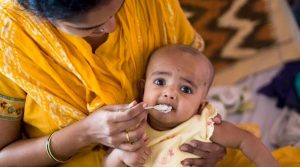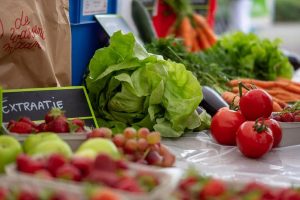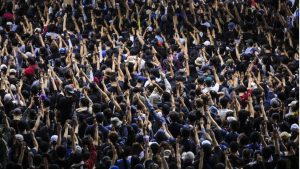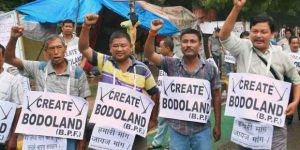Daily Current Affairs for Government Exams:
Today Current Affairs: 17th October 2020 for UPSC IAS exams, State PSC exams, SSC CGL, State SSC, RRB, Railways, Banking Exam & IBPS, etc
Table of Contents
Contents:
- Global Hunger Index, 2020 released
- The World Wildlife Fund (WWF) has published the report “Bending the Curve: The Restorative Power of Planet-Based Diets”.
- Protests in Thailand:
- Bodoland Statehood Movement:
- New START treaty:
- Other important current affairs:
1.Global Hunger Index, 2020 released:

The report is a peer-reviewed publication released annually by Welthungerhilfe and Concern Worldwide.
- The GHI scores are based on a formula that captures three dimensions of hunger—insufficient caloric intake, child undernutrition, and child mortality—using four component indicators:
- UNDERNOURISHMENT: the share of the population that is under-nourished, reflecting insufficient caloric intake
- CHILD WASTING: the share of children under the age of five who are wasted (low weight-for-height), reflecting acute undernutrition.
- CHILD STUNTING: the share of children under the age of five who are stunted (low height-for-age), reflecting chronic undernutrition.
- CHILD MORTALITY: the mortality rate of children under the age of five.
- The GHI ranks countries on a 100-point scale, with 0 being the best score (no hunger) and 100 being the worst. Values less than 10 reflect low hunger, values from 20 to 34.9 indicate serious hunger; values from 35 to 49.9 are alarming, and values of 50 or more are extremely alarming.
Key findings:
- India has the highest prevalence of wasted children under five years in the world, which reflects acute undernutrition.
- India ranks 94 out of 107 countries in the Index, lower than her neighbors such as Bangladesh (75) and Pakistan (88).
- The report put India under the serious category with a score of 27.2.
- The child stunting rate in India was 37.4 %.
- The child wasting was at 17.3 %.
- The undernourishment rate of India was at 14% and child mortality at 3.7 %.
2. The World Wildlife Fund (WWF) has published the report “Bending the Curve: The Restorative Power of Planet-Based Diets”.:

The report offered a detailed analysis of food consumption patterns in 147 countries and six regions and the national dietary guidelines (NDGs) across 75 countries. For each country and region, the impacts of diets were assessed on various environmental and health indicators.
- Food consumption patterns vary widely and can best be characterized by massive inequality.
- Different consumption patterns are observed in the richest and poorest countries, with European countries consuming approximately 600 grams per day more food (1,800 g/day) than African countries (1,200 g/day).
- Although under-nutrition and obesity affect almost all countries, the rate of underweight people is up to 10 times higher in the poorest countries as compared to other countries.
- The rate of overweight/obese people is up to five times higher in the richest countries.
- Premature deaths in low- and middle-income countries due to unhealthy diets, under-consumption as well as over-consumption.
- India needs to be extra careful in figuring out the changes in the diet because there could be an increase in biodiversity loss due to a shift to a healthier and planet-friendly diet and extensively increased consumption.
- The country has to first increase the consumption of fruits, vegetables, and dairy to meet its nutritional requirements.
3.Protests in Thailand:

Thailand’s government banned gatherings of more than five people in the face of three months of escalating demonstrations that have targeted the King as well as the Prime Minister.
- Initially, the government allowed peaceful and lawful protests but now stringent control, due to anarchy in protests.
- The roots of the current discontentment go back to the 2014 coup which brought the junta (military dictatorship) in power which tightened its grip on power and introduced more and more restrictions on the public.
- In 2017, the military introduced a new Constitution, which allowed the military to appoint a 250-member Senate that would play a role in selecting the Prime Minister.
- The country held the delayed Parliamentary election in 2019, which was seen as a mere exercise to transfer power from the junta to an elected government.
- Role of Monarchy: Thailand’s royal family has considerable influence over the country’s political system and is revered by citizens.
- Many, particularly young Thais, have increasingly started questioning the monarchy’s role, its privileges, and the power it has exerted in the country for years.
- Latest Cause: Anti-government protests emerged last year after courts banned the most vocal opposition party.
- This political party was relatively new and had been formed in 2018, with the goals to restrain the military’s powers and interference in the political spectrum and to tackle social and economic inequality in the country.
The Protest:
- Most of the protestors are students and young people in their 20s. There is no overall leader.
- The Free Youth Movement, which was behind the first major protest in July.
- The United Front of Thammasat and Demonstration, a student group from Bangkok’s Thammasat University, which has championed calls for monarchy reform.
- The Bad Student Movement of high-schoolers, which seeks education reform.
Demands:
- Reforms to the Monarchy: Students submitted 10 demands to the government, asking for a separation of the King’s assets and the Crown Property Bureau (quasi-government institution to manage the monarch’s property in Thailand).
- They also wanted to cut the Palace’s share in the national budget, a ban on the King from expressing his political views, and safeguards to prevent him from endorsing future coups.
- Some protesters want to reverse a 2017 increase in the king’s constitutional powers, made the year after he succeeded his widely revered late father King Bhumibol Adulyadej.
- The Lese Majeste Laws: The monarchy is protected by Section 112 of the Penal Code, which says whoever defames, insults or threatens the king, queen, heir-apparent or regent shall be jailed for three to 15 years.
- This law has remained virtually unchanged since the creation of the country’s first criminal code in 1908, although the penalty was toughened in 1976.
- Protesters also seek the scrapping of lese majeste laws.
- Pro-democracy activists say that Thailand is backtracking on the constitutional monarchy established when absolute royal rule ended in 1932.
- Also, the monarchy is too close to the army and argues that this has undermined democracy.
Other Demands:
- The students have also called for the Prime Minister’s resignation; a new Constitution; fresh, free and fair elections; and an end to attacks on dissidents and opposition parties such as the Future Forward Party.
4.Bodoland Statehood Movement:

A new organization (All India Bodo People’s National League for Bodoland Statehood) has announced the revival of the Bodoland statehood movement ahead of the elections to the Bodoland Territorial Council (BTC).
- About Bodos: These are the single largest community among the notified Scheduled Tribes in Assam. Part of the larger umbrella of Bodo-Kachari, the Bodos constitute about 5-6% of Assam’s population.
About Bodo Statehood Movement:
- 1967-68: First organised demand for a Bodo state came under the banner of the political party Plains Tribals Council of Assam.
- 1986: The armed group Bodo Security Force arose, which subsequently renamed itself ‘National Democratic Front of Bodoland (NDFB)’, an organization that is known to be involved in attacks, killings, and extortions.
- It later split into factions.
- 1987: All Bodo Students Union (ABSU) renewed the demand.
- A fallout of the Assam Movement (1979-85), whose culmination – the Assam Accord – addressed the demands of protection and safeguards for the “Assamese people”, leading the Bodos to launch a movement to protect their own identity.
- 1990s: Indian security forces launched extensive operations against the NDFB, causing the latter to flee to bordering Bhutan.
- In Bhutan, the group faced stiff counter-insurgency operations by the Indian Army and the Royal Bhutan Army in the early 2000s.
Government Interventions:
- 1993 Bodo Accord: The ABSU-led movement from 1987 culminated in a 1993 Bodo Accord, which paved the way for a Bodoland Autonomous Council (BAC), but ABSU withdrew its agreement and renewed its demand for a separate state.
- 2003 Bodo Accord: In 2003, the second Bodo Accord was signed by the extremist group Bodo Liberation Tiger Force (BLTF), the Centre and the state. This led to the Bodoland Territorial Council (BTC).
- BTC is an autonomous body under the Sixth Schedule of the Constitution.
- The area under the jurisdiction of BTC was called the Bodo Territorial Autonomous District (BTAD).
2020 Accord: The Central government signed a tripartite agreement with the state government and different Bodo groups, including four factions of the National Democratic Front of Bodoland (NDFB), for a “permanent” solution to the Bodo issue. - Some features:
- It provides for “alteration of area of BTAD” and “provisions for Bodos outside BTAD”
- The BTAD was renamed Bodoland Territorial Region (BTR).
- It provides for more legislative, executive, administrative and financial powers to BTC.
- Provision for rehabilitation of surrendered militants of NDFB and bringing a special development package of Rs. 1,500 crore for the region.
According to the new organisation, the new (2020) accord has been a betrayal of the Bodo people. Besides being an inferior accord, it prescribes a reduction of the area currently under the BTC.
The accord has a provision for excluding from the BTR villages with more than 50% non-Bodos and including villages with more than 50% Bodo people left out of the BTC map after the 2003 accord.
5.New START treaty:

President Vladimir Putin has proposed a one-year extension without conditions of the last major nuclear arms reduction accord- the New START treaty- between Russia and the U.S.
About the New START deal:
- It is a nuclear arms reduction treaty between the United States and the Russian Federation with the formal name of Measures for the Further Reduction and Limitation of Strategic Offensive Arms.
- Signed on 8 April 2010 in Prague, and, after ratification entered into force on 5 February 2011.
- Replaced the Treaty of Moscow (SORT), which was to expire in December 2012.
- Its name is a follow-up to the START I treaty, which expired in December 2009, the proposed START II treaty, which never entered into force, and the START III treaty, for which negotiations were never concluded.
Under terms of the treaty:
- The number of strategic nuclear missile launchers will be reduced by half.
- A new inspection and verification regime will be established, replacing the SORT mechanism.
- The number of deployed strategic nuclear warheads is limited to 1,550.
- The number of deployed and non-deployed intercontinental ballistic missile (ICBM) launchers, submarine-launched ballistic missile (SLBM) launchers, and heavy bombers equipped for nuclear armaments to 800 will be limited.
Other important current affairs:
1.The managing committee of the Indian Banks’ Association (IBA) has elected Union Bank of India’s MD and CEO Rajkiran Rai G. as the association’s chairman for 2020-21.
- Indian Banks’ Association (IBA): Formed in 1946.
- It is a representative body of management of banking in India operating in India – an association of Indian banks and financial institutions based in Mumbai.
- IBA was formed for the development, coordination, and strengthening of Indian banking, and assist the member banks in various ways including implementation of new systems and adoption of standards among the members.
- Members: With an initial membership representing 22 banks in India in 1946, IBA currently represents 237 banking companies operating in India.
2.Union Health Minister said that the aim of the government is to make India Trans Fat free by 2022, a year ahead of the target set by the World Health Organization.
- Trans fats, or trans-fatty acids, are a form of unsaturated fat. They come in both natural and artificial forms.
- Natural, or ruminant, trans fats occur in the meat and dairy from ruminant animals, such as cattle, sheep, and goats. They form naturally when bacteria in these animals’ stomachs digest grass.
- However, artificial trans fats — otherwise known as industrial trans fats or partially hydrogenated fats — are hazardous to your health. These fats occur when vegetable oils are chemically altered to stay solid at room temperature, which gives them a much longer shelf life.
- Artificial trans fats may increase your risk of heart disease. In 2018 the World Health Organization launched a plan to eliminate trans-fat from the global food supply.
3.C Rangarajan (former Chairman, Prime Minister’s Economic Advisory Council) argued that there is an urgent need to reach young people both for reproductive health education and services as well as to cultivate gender equity norms.
- His arguments are based on the Sample Registration System (SRS) Statistical Report (2018) and the United
- Nations Population Fund (UNFPA) State of World Population 2020.
- Sex Ratio at Birth:
- The biologically normal sex ratio at birth is 1,050 males to 1,000 females or 950 females to 1,000 males.
- The SRS Report 2018 shows that sex ratio at birth in India, declined marginally from 906 in 2011 to 899 in 2018.
- The sex ratio is measured as the number of females per 1,000 males.
- The UNFPA State of World Population 2020 estimated the sex ratio at birth in India as 910, which is on the lower side of index.
- This is a cause for concern because this adverse ratio results in a gross imbalance in the number of men and women and its inevitable impact on marriage systems as well as other harms to women.
- Total Fertility Rate (TFR):
- According to SRS Report 2018, TFR has been declining in India for some time now. It declined from 2.4 to 2.2 during the period between 2011 and 2018.
- In 2011, 10 states had a fertility rate below the replacement rate.
- This increased to 14 states in 2020.
- Fertility is likely to continue to decline and it is estimated that replacement TFR of 2.1 would soon be reached for India as a whole.
- TFR is the number of children a mother would have at the current pattern of fertility during her lifetime.
- The replacement rate is the average number of children born per woman—at which a population exactly replaces itself from one generation to the next, without migration.
- Many people believe that the population would stabilize or begin to reduce in a few years once replacement fertility is reached.
- However, this is not so because of the population momentum effect, a result of more people entering the reproductive age group of 15-49 years due to the past high-level of fertility.
- For instance, the replacement fertility level was reached in Kerala around 1990, but its annual population growth rate was 0.7% in 2018, nearly 30 years later.
4.According to a recent research paper, human emissions of nitrous oxide (N2O) have increased by 30% between 1980 and 2016.
- The research was conducted through an international collaboration between the International Nitrogen Initiative (INI) and the Global Carbon Project of Future Earth, a partner of the World Climate Research Programme.
- Nitrous Oxide (N2O) is a greenhouse gas (GHG) 300 times more potent than carbon dioxide (CO2).
- It has the third-highest concentration, after CO2 and methane (CH4), in Earth’s atmosphere among GHGs responsible for global warming.
- N2O is also the only remaining threat to the ozone (O3) layer, for it accumulates in the atmosphere over a long period of time, just like CO2.
- It can live in the atmosphere for up to 125 years.
- Its global concentration levels have increased from 270 parts per billion (ppb) in 1750 to 331 ppb in 2018, a jump of 20%.
- The growth has been the quickest in the past five decades because of human emissions.
5.Centre has announced new guidelines for digital news platforms.
- New Guidelines:
- The government has put emphasis on compliance with the 26% Foreign Direct Investment (FDI) cap under the government approval route in digital media.
- 26% FDI through the government approval route in the digital media sector was brought in 2019. FDI in print media is capped at 26%, and that in TV news is 49%.
- The majority of the directors on the company’s board and the Chief Executive Officer (CEO) of the company would have to be an Indian citizen.
- All foreign employees working for more than 60 days would need a security clearance.
- If the government denies or withdraws security clearance, the digital media company will ensure that the concerned person resigns or his/her services are terminated.
- The government has given a year to digital media news entities to align their shareholding with these requirements.
6.National Institute of Ocean Technology (NIOT), Chnnai has developed an eco-friendly crude oil bioremediation mechanism technology using consortia (group of two or more species) of marine microbes wheat bran (WB) immobilized (microbes controlled degradation) on agro-residue bacterial cells.
- Wheat bran is the hard outer layer of the wheat kernel. It’s stripped away during the milling process.
- Eco-friendly Crude Oil Bioremediation Mechanism Technology
- Bioremediation: It can be defined as any process that uses microorganisms or their enzymes to remove and or neutralize contaminants within the environment to their original condition.
- In the marine ecosystem, deep-sea hydrocarbonoclastic (ability to degrade hydrocarbon) microbial consortium plays an important role in breaking down oil in the event of a spill.
- The microbial community serves as energetic primary degraders of a complex mixture of petroleum hydrocarbons into various aldehydes, ketones and acidic metabolites.
- These hydrocarbon-degrading bacteria don’t depend on hydrocarbons for survival but have a metabolic mechanism where they use petroleum products as carbon and energy source and thus, help cleaning up oil spills.
- The complete breakdown and degradation of crude oil is achievable using wheat bran marine bacterial consortia (which are low-cost non-toxic agro-residues) in an environmentally sustainable manner.
7.Philippine government has decided to resume oil exploration in its exclusive economic zone, a 320-km stretch of waters where a coastal state can exclusively exploit maritime resources under the 1982 U.N. Convention on the Law of the Sea.
- This includes Reed Bank, which China also claims. This region is located in the disputed South China Sea.
- It is a dispute over territory and sovereignty over ocean areas, and the Paracels and the Spratlys – two island chains claimed in whole or in part by a number of countries.
- Alongside the fully-fledged islands, there are dozens of rocky outcrops, atolls, sandbanks and reefs, such as the Scarborough Shoal.
- China: claims by far the largest portion of territory – an area defined by the “nine-dash line” which stretches hundreds of miles south and east from its most southerly province of Hainan.
- Vietnam: hotly disputes China’s historical account, saying China had never claimed sovereignty over the islands before the 1940s. Vietnam says it has actively ruled over both the Paracels and the Spratlys since the 17th Century – and has the documents to prove it.
- Philippines: both the Philippines and China lay claim to the Scarborough Shoal (known as Huangyan Island in China) – a little more than 100 miles (160km) from the Philippines and 500 miles from China.
- Malaysia and Brunei: They lay claim to territory in the South China Sea that they say falls within their economic exclusion zones, as defined by UNCLOS – the United Nations Convention on the Law of the Sea. Brunei does not claim any of the disputed islands, but Malaysia claims a small number of islands in the Spratlys
8.The Insurance Regulatory and Development Authority of India (IRDAI) has advised public sector general insurers to appoint a nodal officer each for the 17 insurance ombudsman offices to ensure proper and timely disposal of complaints.
- The Insurance Ombudsman scheme was created by the Government of India for individual policyholders to have their complaints settled out of the courts system in a cost-effective, efficient and impartial way.
- Any person who has a grievance against an insurer, may himself or through his legal heirs, nominee or assignee, make a complaint in writing to the Insurance ombudsman.
- One can approach the Ombudsman with complaint only if:




